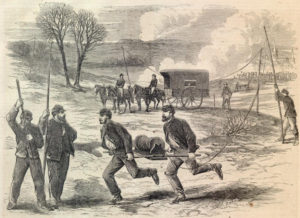 In October 1861, California Chief Justice Stephen Johnson Field reportedly sent a message to Abraham Lincoln via the newly completed transcontinental telegraph. The event was a milestone that predated the later transcontinental railroad.
In October 1861, California Chief Justice Stephen Johnson Field reportedly sent a message to Abraham Lincoln via the newly completed transcontinental telegraph. The event was a milestone that predated the later transcontinental railroad.
By 1860 a network of telegraph lines covered much of the eastern United States. After the 1849 gold rush had spawned a rapid populating of the newly acquired California coast, telegraph lines quickly grew in that new state. But there was a huge gap in service through the central United States. The U.S. Congress authorized a transcontinental telegraph project in 1860, and like the transcontinental railroad that came after it, the telegraph system was built by separate crews that would meet in the middle. The Pacific Telegraph Company would start in Nebraska and head west while the Overland Telegraph Company would build east from Nevada, which was connected to the California network. Essentially the route followed that established by the Pony Express and the Overland stagecoach line.
It took just over three months to plant more than 27,000 poles carrying 2,000 miles of single-strand iron wire over prairies and mountains. The transcontinental telegraph was officially completed on October 24, 1861 in Salt Lake City and became a critical communication line for the Union. Justice Fields often gets credit for sending the first transcontinental telegraph to Lincoln; however, there is some uncertainty about this. In fact, documents show that on October 20, 1861 Lincoln replied by telegraph to Frank Fuller, the Governor of the Utah Territory reciprocating his congratulations for the telegraph achievement. Lincoln wrote:
Sir.
The completion of the Telegraph to Great Salt Lake City is auspicious of the Stability & Union of the Republic.
The Government reciprocates your Congratulations
ABRAHAM LINCOLN
Fuller’s original telegraph message to Lincoln from earlier that day says:
`To the President of the United States:— Great Salt Lake City.
“Utah, whose citizens strenuously resist all imputations of disloyalty, congratulates the President upon the completion of an enterprise which spans the continent, unites two oceans and connects remote extremities of the body politic with the great government heart. May the whole system speedily thrill with quickened pulsations of that heart, the parricidal hand of political treason be punished, and the entire sisterhood of States join hands in glad reunion around the national fireside.
“FRANK FULLER,
“Acting Governor of Utah.”
So did Field send the first transcontinental telegraph message to Lincoln? Or did Fuller? Evidence suggests the latter. In either case, the telegraph played a hugely important role in the Civil War, and like many other technology-based advantages, helped the Union more than the Confederacy.
By the way, in May of 1863 Lincoln appointed Field as a U.S. Supreme Court Associate Justice, thus becoming the first person to fill the newly created extra seat after Congress expanded the Supreme Court from 9 to10. But that’s a story for another time.
David J. Kent is an avid science traveler and the author of Lincoln: The Man Who Saved America, in Barnes and Noble stores now. His previous books include Tesla: The Wizard of Electricity and Edison: The Inventor of the Modern World and two specialty e-books: Nikola Tesla: Renewable Energy Ahead of Its Time and Abraham Lincoln and Nikola Tesla: Connected by Fate.
Check out my Goodreads author page. While you’re at it, “Like” my Facebook author page for more updates!











In this part of the country, the telegraph was most noteworthy for bringing about the sudden demise of the Pony Express. The remains of abandoned PE stations dot the countrysides to the east.
In the historical context of the opening of this part of the country, Fuller’s message and Lincoln’s reply are also very interesting. This state was expanded three times after its statehood in 1864, twice to the east and once to the south, each time to lay claim to some resource of value within that territory which remained of the once proposed state of “Deseret”.
Interesting. I wasn’t aware of the level of expansion of Nevada after it became a state. Guess they had good lobbyists.
I do know that it was rushed into statehood just before the 1864 election. So rushed, in fact, that they telegraphed the entire state constitution to Washington so it could be accepted by Congress (knowing ahead of time, of course, that they would be voting for Lincoln instead of McClellan). [Pony Express was way too slow, and apparently not long for existence] Nevada also had a silver boom, which helped increase its population and incentivize the federal authorities to bring it in quickly as a state.
Yes… Nevada’s motto is “Battle Born”, in reference to its (financial) support of the north during the Civil War. Nevada’s population was actually insufficient to justify statehood. But things were fudged due to the extensive silver deposits found in the northern part of the state. The two eastern expansions covered gold discoveries in the then remaining Utah Territory, and the southern expansion covered Mormon farming in what’s now the Las Vegas area south of the Missouri Compromise after that boundary was no longer recognized.
So silver and gold paved the way to statehood. The California gold rush led to that state also being fast-tracked for statehood. And today oil seems to drive policy.
Pingback: Abraham Lincoln’s Use of the Telegraph in the Civil War – David J. Kent